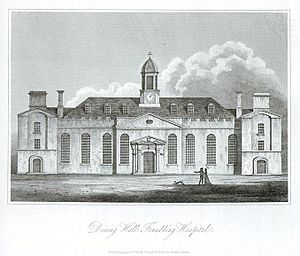House of Industry (Dublin) facts for kids
A House of Industry was a special kind of workhouse in Dublin, Ireland. It was created in 1703 by a law passed in parliament. Its main goal was to give jobs and a place to live for poor people in Dublin.
From 1729, the House of Industry also included a foundling hospital. This part of the institution looked after babies and young children who had been abandoned.
The main House of Industry was located where St. James's Hospital is today, on James's Street. It covered a large area of about 14 acres (about 56,000 square meters). Money to run this place came from taxes. These taxes were collected from things like sedan chairs (chairs carried by people), hackney coaches (taxis), and a special House Tax across the city. After these taxes stopped in 1823, the Irish Parliament mostly paid for the institution.
By 1796, more than 1,700 people lived there. The Irish Parliament later put seven 'governors' in charge. These governors were chosen each year by members of Dublin Corporation. Around this time, new ideas from Benjamin Thompson were used to make the building better. These improvements helped with air circulation, cooking, and heating.
One person, Thomas Bernard, wrote in 1799 that this place was different from similar places in Great Britain. He said that Ireland did not have specific laws or local taxes to support the poor. The House of Industry was set up to offer work and care for Dublin's poor. It also aimed to deal with beggars and people without homes who were on the streets.
The House of Industry offered a place to stay for beggars, people who wandered without homes, abandoned children under eight, and people with mental health issues. In 1773, the workhouse was changed. It was divided into a hospital for people with mental health problems, a workhouse for the poor, and a foundling hospital. The foundling hospital was mainly for the safety and education of the children it took in.
This foundling hospital took in abandoned babies from Dublin. However, many children sadly died there. Investigations found serious problems with how the hospital was run. Because of these issues, the House of Commons stopped allowing new children to be admitted to the hospital in 1831.
The part of the workhouse where beggars and people without homes were sent also faced problems. In 1805, Sir John Carr visited and described it as a sad place. He said it was filled with need, sickness, and trouble. Parliament eventually believed the House of Industry was not working well and called it "completely worthless."
The French thinker Alexis de Tocqueville also visited this place, sometimes called 'the Dublin Poor House', in 1835. He was on a trip to learn about Ireland. Tocqueville described the conditions for the people living there as very difficult and sad. The food given was soup made from leftover food collected from wealthy people.
In 1838, a new law called the Irish Poor Law was passed. After this, the House of Industry on James's Street became known as the South Dublin Union.
Another House of Industry: Channel Row
Another House of Industry was started in 1773. This one was in Channel Row, which is now called North Brunswick Street. It was on the north side of Dublin, in an area known as Grangegorman, close to where the Royal Canal Harbour later was.
In 1838, when the Irish Poor Law was passed, this second House of Industry became known as the North Dublin Union.
Later, in 1919, the North Dublin Union joined with the South Dublin Workhouse. The old North Dublin buildings were then used for other purposes. From that point on, the combined institution was simply called the Dublin Union.
See also
- Irish Poor Laws
- Mendicity Institution
- House of Industry
Sources
- Chapter X from Life in old Dublin by James Collins 1913



